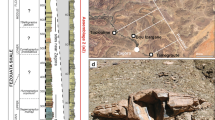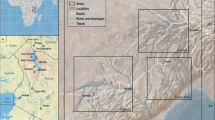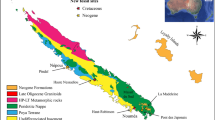Abstract
How well the ecology, zoogeography and evolution of modern biotas is understood depends substantially on knowledge of the Pleistocene1,2. Australia has one of the most distinctive, but least understood, Pleistocene faunas. Records from the western half of the continent are especially rare3. Here we report on a diverse and exceptionally well preserved middle Pleistocene vertebrate assemblage from caves beneath the arid, treeless Nullarbor plain of south-central Australia. Many taxa are represented by whole skeletons, which together serve as a template for identifying fragmentary, hitherto indeterminate, remains collected previously from Pleistocene sites across southern Australia. A remarkable eight of the 23 Nullarbor kangaroos are new, including two tree-kangaroos. The diverse herbivore assemblage implies substantially greater floristic diversity than that of the modern shrub steppe, but all other faunal and stable-isotope data indicate that the climate was very similar to today. Because the 21 Nullarbor species that did not survive the Pleistocene were well adapted to dry conditions, climate change (specifically, increased aridity) is unlikely to have been significant in their extinction.
This is a preview of subscription content, access via your institution
Access options
Subscribe to this journal
Receive 51 print issues and online access
$199.00 per year
only $3.90 per issue
Buy this article
- Purchase on Springer Link
- Instant access to full article PDF
Prices may be subject to local taxes which are calculated during checkout



Similar content being viewed by others
References
FAUNMAP Working Group. Spatial response of mammals to Late Quaternary environmental fluctuations. Science 272, 1601–1606 (1996)
Lister, A. M. The impact of Quaternary Ice Ages on mammalian evolution. Phil. Trans. R. Soc. Lond. B 359, 221–241 (2004)
Prideaux, G. J. in Encyclopedia of Quaternary Science (ed. Elias, S.) 1518–1537 (Elsevier, Oxford, 2006).
Beard, J. S. Vegetation Survey of Western Australia: Nullarbor. 1:1,000,000 Vegetation Series. Explanatory Notes to Sheet 4 (University of Western Australia, Perth, 1975)
Lowry, D. C. Geology of the Western Australian part of the Eucla Basin. Geol. Surv. West. Aust. Bull. 122, 1–201 (1970)
Lundelius, E. L. & Turnbull, W. D. The mammalian fauna of Madura Cave, Western Australia. Part VII: Macropodidae: Sthenurinae, Macropodinae, with a review of the marsupial portion of the fauna. Fieldiana Geol. ns. 17, 1–71 (1989)
Burbidge, N. T. The phytogeography of the Australian region. Aust. J. Bot. 8, 75–212 (1960)
Keast, A. (ed.) Ecological Biogeography of Australia (W. Junk, The Hague, 1981)
Woodhead, J. et al. U–Pb geochronology of speleothems by MC-ICPMS. Quat. Geochronol. 1, 208–221 (2006)
Prideaux, G. J. et al. Mammalian responses to Pleistocene climate change in southeastern Australia. Geology 35, 33–36 (2007)
Prideaux, G. J. Systematics and Evolution of the Sthenurine Kangaroos (Univ. Calif. Publ. Geol. Sci. no. 146, 2004)
Prideaux, G. J., Gully, G. A., Ayliffe, L. K., Bird, M. I. & Roberts, R. G. Tight Entrance Cave, southwestern Australia: a late Pleistocene vertebrate deposit spanning more than 180 ka. J. Vertebr. Paleontol. 20, 62A–63A (2000)
Baynes, A. in A Biological Survey of the Nullarbor Region, South and Western Australia in 1984 (eds McKenzie, N. L. & Robinson, A. C.) 139–152 (Department of Environment and Planning, Adelaide, 1987)
Strahan, R. (ed.) The Mammals of Australia (Reed New Holland, Sydney, 1995)
Solem, A. Pupilloid land snails from the south and mid-west coasts of Australia. J. Malacol. Soc. Aust. 7, 95–124 (1986)
Passey, B. H. et al. Carbon isotope fractionation between diet, breath CO2, and bioapatite in different mammals. J. Archaeol. Sci. 32, 1459–1470 (2005)
Cerling, T. E. et al. The reaction progress variable in stable isotope studies of biological tissue turnover. Oecologia (in the press).
Koch, P. L. Isotopic reconstruction of past continental environments. Annu. Rev. Earth Planet. Sci. 26, 573–613 (1998)
Bureau of Meteorology. Climate of Australia (Australian Government Publishing Service, Canberra, 1989)
Mitchell, A. A. & Wilcox, D. G. Arid Shrubland Plants of Western Australia (Univ. of Western Australia Press, Perth, 1998)
Miller, G. H. et al. Ecosystem collapse in Pleistocene Australia and a human role in megafaunal extinction. Science 309, 287–290 (2005)
Murray, P. F. & Vickers-Rich, P. Magnificent Mihirungs: The Colossal Flightless Birds of the Australian Dreamtime (Univ. of Indiana Press, Bloomington, Indiana, 2004)
Horton, D. R. in Quaternary Extinctions: A Prehistoric Revolution (eds Martin, P. S. & Klein, R. G.) 639–680 (Univ. of Arizona, Tucson, 1984)
Wroe, S. & Field, J. A review of the evidence for a human role in the extinction of Australian megafauna and an alternative interpretation. Quat. Sci. Rev. 25, 2692–2703 (2006)
Roberts, R. G. et al. New ages for the last Australian megafauna: continent-wide extinction about 46,000 years ago. Science 292, 1888–1892 (2001)
McKenzie, N. J., Jacquier, D., Isbell, R. F. & Brown, K. Australian Soils and Landscapes: An Illustrated Compendium (CSIRO Publishing, Melbourne, 2004)
Roberts, R. G. et al. Preliminary luminescence dates for archaeological sediments on the Nullarbor Plain, South Australia. Aust. Archaeol. 42, 7–16 (1996)
Lian, O. B. & Roberts, R. G. Dating the Quaternary: progress in luminescence dating of sediments. Quat. Sci. Rev. 25, 2449–2468 (2006)
Johnson, C. N. & Prideaux, G. J. Extinctions of herbivorous mammals in Australia’s late Pleistocene in relation to their feeding ecology: no evidence for environmental change as cause of extinction. Aust. Ecol. 29, 553–557 (2004)
Acknowledgements
We thank P. Ackroyd, K. Boland, R. Gibbons, G. MacLucas, J. MacLucas and E. Taylor for bringing their discoveries to our attention, and for cave mapping and field assistance; C. Bryce, G. Deacon, L. Hatcher, D. Megirian and M. Norton for field assistance; G. Kendrick and A. Baynes for identifying gastropod and rodent fossils, respectively; and P. Latz, J. Magee, D. Megirian, G. Miller and P. Murray for discussions. This study was supported by two grants from the Rio Tinto WA Future Fund to the Western Australian Museum. Isotopic analysis was funded by a US National Science Foundation grant.
Author Contributions G.J.P. was responsible for site descriptions, faunal analysis, data synthesis and writing the paper, J.A.L. fieldwork coordination, L.K.A. stable isotope analysis, J.C.H. U-series dating, B.P. magnetic polarity assessment, M.N.H. lizard identifications, W.E.B. bird identifications, R.G.R., M.L.C. and L.J.A. optical dating, P.D.D. site interpretation, and N.M.W. small marsupial identifications.
Author information
Authors and Affiliations
Corresponding author
Ethics declarations
Competing interests
Reprints and permissions information is available at www.nature.com/reprints. The authors declare no competing financial interests.
Supplementary information
Supplementary Information
This file contains Supplementary Table 1-8, Supplementary Figures 1-6 with legends, Supplementary notes and additional references. The file consists of geochronological results, observations on depositional environments and processes, and palaeoecological data too detailed to include in the main text, but which directly underpin it. (PDF 683 kb)
Rights and permissions
About this article
Cite this article
Prideaux, G., Long, J., Ayliffe, L. et al. An arid-adapted middle Pleistocene vertebrate fauna from south-central Australia. Nature 445, 422–425 (2007). https://doi.org/10.1038/nature05471
Received:
Accepted:
Issue Date:
DOI: https://doi.org/10.1038/nature05471
This article is cited by
-
Macropod Bone Apatite Isotopic Analysis as Evidence for Recent Environmental Change at Bandicoot Bay Pearling Camp, Barrow Island, Australia
International Journal of Historical Archaeology (2022)
-
Functional traits of the world’s late Quaternary large-bodied avian and mammalian herbivores
Scientific Data (2021)
-
Optically stimulated luminescence dating using quartz
Nature Reviews Methods Primers (2021)
-
Extinction of eastern Sahul megafauna coincides with sustained environmental deterioration
Nature Communications (2020)
-
The antiquity of Nullarbor speleothems and implications for karst palaeoclimate archives
Scientific Reports (2019)
Comments
By submitting a comment you agree to abide by our Terms and Community Guidelines. If you find something abusive or that does not comply with our terms or guidelines please flag it as inappropriate.



